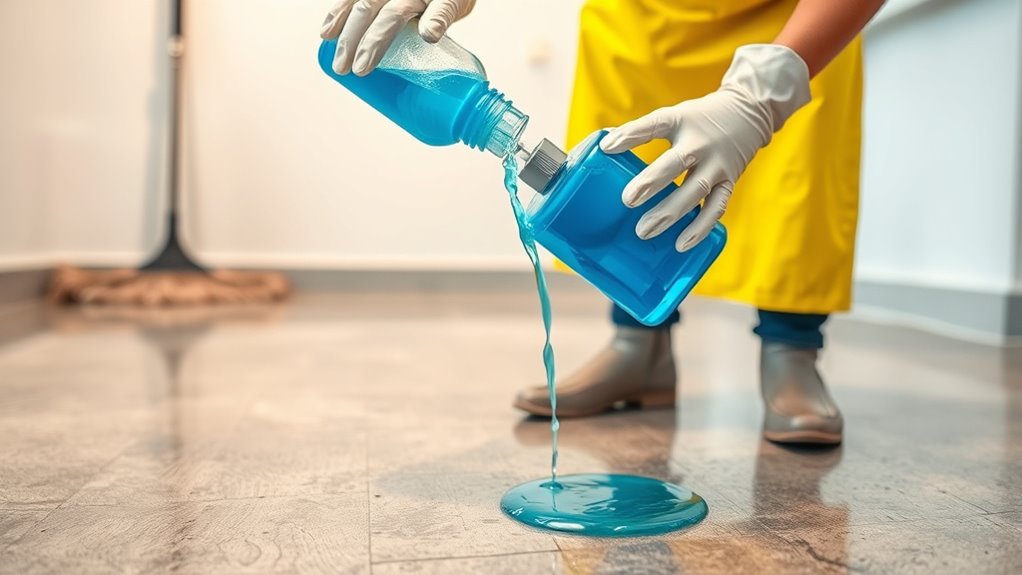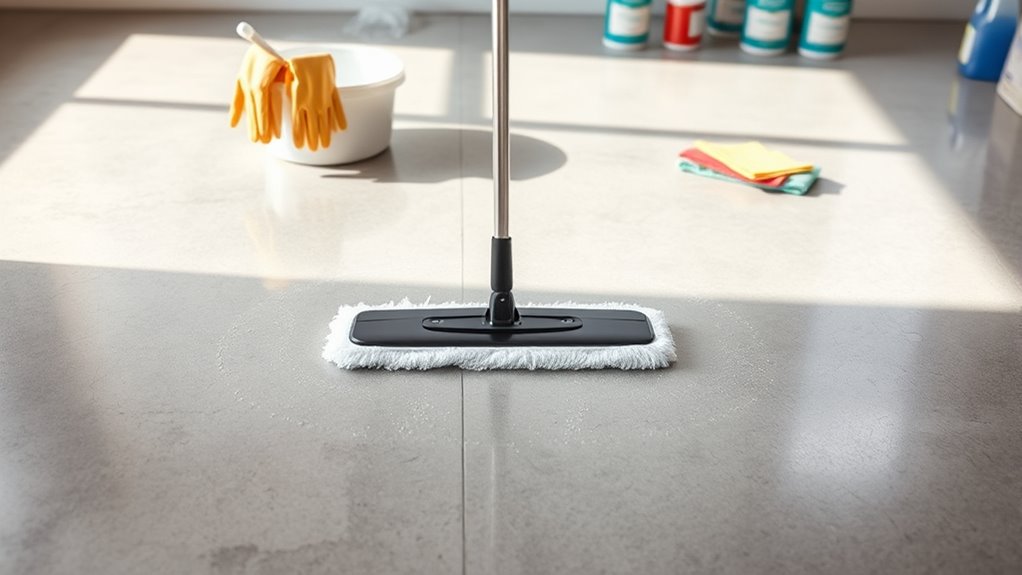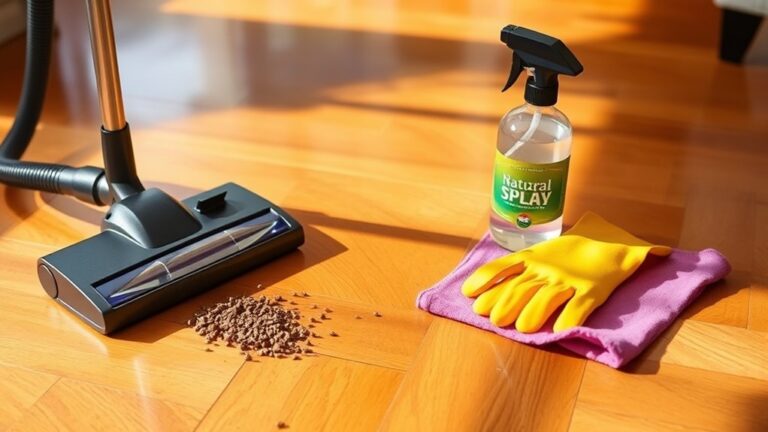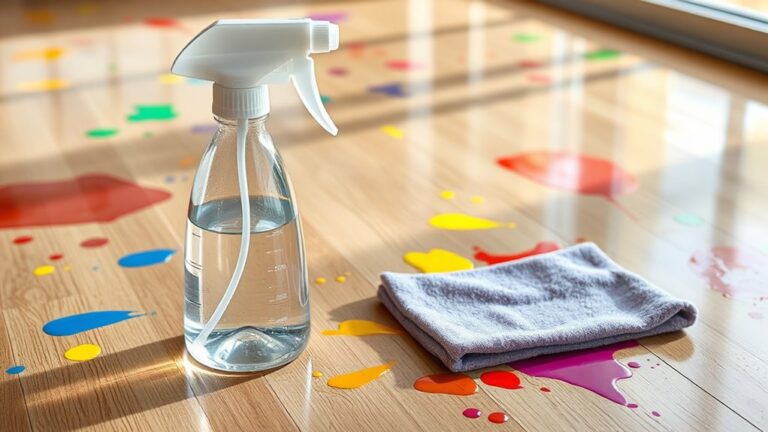You’ll want to start by gathering supplies like a broom, mop, pH-neutral cleaner, and protective gear. Begin by sweeping up loose dirt and debris, then prepare and evenly apply your cleaning solution. Scrub the floor with a stiff brush or scrubber, rinse thoroughly to avoid residue, and dry completely using a squeegee or wet vacuum. Treat any stains with specialized cleaners, then apply a sealer for lasting protection. Following these steps will guarantee you clean your concrete piso effectively and confidently.
Reúne tus suministros de limpieza

Before you begin cleaning your concrete floors, you’ll need to gather the right supplies to guarantee an effective job. Start with essential cleaning tools: a stiff-bristle broom or a dust mop to handle dirt, a mop with a bucket, and a scrub brush for stubborn stains. Choose a pH-neutral cleaner designed for concrete to avoid damage. Don’t forget gloves and safety glasses for protection. For floor maintenance, consider a wet vacuum to remove excess water quickly, preventing slips and prolonging floor life. Having these tools ready assures you work efficiently and confidently. Proper preparation sets the foundation for thorough cleaning, letting you maintain your concrete floors with freedom and ease. Stay organized, and your floor maintenance routine will be smooth and effective.
Remove Loose Dirt and Debris
Start by sweeping the concrete floor thoroughly to collect loose dirt and larger debris. Follow up with a dust mop to capture finer particles that the broom might miss. This two-step process guarantees the surface is properly prepared for deeper cleaning.
Sweep Thoroughly First
Although it might seem simple, sweeping your concrete floor thoroughly is essential to remove all loose dirt and debris that can interfere with deeper cleaning. This initial step guarantees your cleaning techniques are more effective and supports long-term floor maintenance. To sweep effectively, follow these steps:
- Start at the farthest corner and work your way toward the exit to avoid stepping on cleaned areas.
- Use a stiff-bristled broom to loosen and collect dirt, especially in corners and textured surfaces.
- Gather debris into manageable piles and remove them promptly to prevent redistribution during cleaning.
Use a Dust Mop
One key step after sweeping is using a dust mop to catch any remaining loose dirt and fine debris that a broom might miss. The dust mop benefits include its ability to trap small particles without scattering them, ensuring a cleaner surface before deeper cleaning. To maximize effectiveness, use slow, deliberate strokes, moving the mop in a figure-eight pattern to cover all areas thoroughly. Pay special attention to corners and edges where dirt tends to accumulate. Regularly shake out or clean the mop head to maintain its efficiency. By incorporating these effective techniques, you’ll prevent dirt from embedding into the concrete, making subsequent cleaning steps easier and preserving the floor’s appearance. This simple method supports your freedom to maintain a clean, low-maintenance concrete floor effortlessly.
Sweep or Vacuum the Floor

You’ll want to start by removing any loose dirt and debris to prevent scratching the concrete during cleaning. Choose a broom with stiff bristles or a vacuum designed for hard floors to guarantee effective debris removal. This step sets a clean surface for the next stage of your cleaning process.
Remove Loose Dirt
Before applying any wet cleaning methods, make certain to remove all loose dirt and debris from your concrete floor. This step is essential for effective dust control and dirt prevention. Here’s how to do it efficiently:
- Start by sweeping the entire floor with a stiff-bristle broom, focusing on corners and edges where dirt accumulates.
- Follow up with a vacuum designed for hard surfaces to pick up finer dust particles that sweeping might miss.
- Dispose of the collected dirt promptly to prevent it from resettling.
Removing loose dirt thoroughly guarantees your concrete floor stays cleaner longer and prepares the surface for deeper cleaning. By tackling dust control at this stage, you maintain a healthier environment and enjoy greater freedom from persistent grime.
Choose Suitable Tools
Selecting the right tools for cleaning your concrete floor can make all the difference in efficiency and results. Start by choosing between sweeping and vacuuming, two primary tool types for removing loose dirt. A stiff-bristled broom works well for outdoor or rough surfaces, while a soft-bristle broom suits smoother indoor floors. If you prefer vacuuming, opt for a shop vacuum with strong suction designed for debris, not a regular household vacuum. This guarantees you pick up fine dust and small particles effectively. Assess your floor’s condition and debris type to decide which cleaning tools fit your needs best. By selecting appropriate tool types, you’ll save time and effort, making your cleaning process smoother and more thorough, giving you the freedom to enjoy your clean space.
Prepare una solución de limpieza
Typically, preparing the right cleaning solution is key to effectively removing dirt and stains from concrete floors without causing damage. You’ll want to carefully select your cleaning agents based on the floor’s condition and stain type. Here’s how to prepare:
- Choose a cleaning agent suitable for concrete, such as pH-neutral cleaners or mild detergents, to avoid etching or discoloration.
- Follow recommended solution ratios—usually one part cleaner to ten parts water—to guarantee effectiveness without over-concentration.
- Mix the solution in a bucket, stirring gently for uniform consistency.
Apply the Cleaning Solution to the Floor

You’ll want to select a cleaning solution that matches your floor’s condition and type to avoid damage. Apply the solution evenly using a mop or sprayer, guaranteeing full coverage without oversaturating the concrete. Remember to wear gloves and make certain of proper ventilation to keep yourself safe during the process.
Elegir la solución adecuada
Before applying any cleaning solution, it’s important to understand the type of stain and the condition of your concrete floor, as this will determine the most effective product to use. You’ll want to select cleaning products tailored to your needs, including eco friendly options that protect both your floor and the environment.
Consider these key factors:
- Stain Type: Grease requires degreasers; mineral stains need acidic cleaners.
- Floor Condition: Sealed floors demand gentle cleaners, while unsealed can handle stronger formulas.
- Safety and Environmental Impact: Opt for non-toxic, biodegradable solutions to maintain your freedom from harsh chemicals.
Técnicas de aplicación adecuadas
Start by thoroughly sweeping or vacuuming the concrete floor to remove any loose dirt and debris that could interfere with the cleaning solution’s effectiveness. Next, choose an application method that suits your space—whether a mop, brush, or spray bottle. Apply the cleaning solution evenly, ensuring full coverage without oversaturating the floor. Use consistent, overlapping strokes to prevent streaking and missed spots. For stubborn stains, let the solution sit briefly before scrubbing gently with a stiff brush. Always follow recommended dilution ratios to maintain the solution’s potency without damaging the concrete. By mastering these cleaning techniques, you’ll maintain your floor’s integrity and appearance while working efficiently. Proper application methods help you clean thoroughly, saving time and effort while protecting your freedom to enjoy a pristine surface.
Safety Precautions During Cleaning
Although applying the cleaning solution is straightforward, taking safety precautions is crucial to protect yourself and your floor. Before you begin, always wear appropriate protective gear like gloves and goggles to shield your skin and eyes from harsh chemicals. Follow these key steps for chemical safety:
- Ventilate the area well by opening windows or using fans to disperse fumes.
- Dilute the cleaning solution exactly as instructed to avoid damaging the concrete or creating hazardous conditions.
- Test a small, inconspicuous spot first to verify the solution doesn’t cause discoloration or surface damage.
Scrub the Floor Thoroughly
Grab a stiff-bristled brush or a floor scrubber to tackle the concrete surface. Use effective tools to loosen dirt and stains. Focus on scrubbing techniques that apply firm, circular motions for deep cleaning without damaging the floor. Work in sections to maintain control and thoroughness.
| Tool Type | Objetivo | Técnica |
|---|---|---|
| Cepillo de cerdas duras | Agitate dirt & debris | Circular scrubbing |
| Floor scrubber | Cover large areas | Back-and-forth motion |
| Handheld brush | Detail corners & edges | Targeted scrubbing strokes |
Rinse the Floor With Clean Water
Once you’ve thoroughly scrubbed the concrete, the next step is to remove loosened dirt and cleaning residues by rinsing the floor with clean water. Using the right water temperature and rinsing techniques will make this process efficient and effective. Follow these steps:
After scrubbing, rinse thoroughly with clean water to remove dirt and cleaning residues effectively.
- Use lukewarm water to avoid damaging the concrete or leaving residue behind.
- Apply water evenly across the floor using a hose with a spray nozzle or a bucket, ensuring you cover all scrubbed areas.
- Employ a squeegee or mop to guide dirty water toward a drain or exit point, preventing pooling and streaks.
Dry the Floor Completely
After rinsing, you’ll want to dry the floor completely to prevent water spots and guarantee safety. Start by removing excess water with a squeegee, pushing it towards a drain or exit. Next, use absorbent towels or microfiber mops to soak up remaining moisture. For larger areas, consider a wet-dry vacuum to speed up the process. Proper drying techniques not only enhance floor maintenance but also reduce slip hazards and surface damage. Ensure good air circulation by opening windows or using fans to accelerate evaporation. Taking these methodical steps helps preserve your concrete’s integrity and appearance, giving you the freedom to enjoy a clean, safe space without worry. Drying thoroughly is vital in every cleaning routine—never skip this important phase.
Treat Stains With Specialized Cleaners
Although thorough cleaning removes most dirt, stubborn stains often require specialized cleaners to fully lift them from concrete floors. To tackle these marks effectively, follow these stain removal techniques using effective cleaners:
- Identify the stain type—oil, rust, or paint—then choose a cleaner formulated specifically for that stain to avoid damage.
- Apply the cleaner directly to the stain, allowing it to sit for the recommended time to break down the residue.
- Scrub gently with a stiff-bristled brush, then rinse thoroughly with clean water and dry the area.
Apply a Sealer for Long-Lasting Protection
Because concrete is porous and prone to wear, applying a sealer is vital to protect your floors from stains, moisture, and abrasion. First, choose from sealer types like penetrating sealers, which soak into the concrete and preserve its natural look, or topical sealers that form a protective film on the surface. Consider your environment and traffic level to select the right one. Before application, verify the floor is clean and dry. Use application techniques such as rolling or spraying evenly, avoiding puddles or missed spots. Apply multiple thin coats rather than a thick single one for better durability. Allow appropriate drying time between coats. Proper sealing extends your floor’s lifespan and reduces maintenance, giving you freedom from frequent cleaning and repairs.




